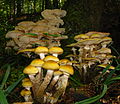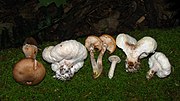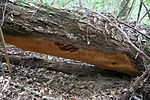Armillaria gallica (synonymous with A. bulbosa and A. lutea) is a species of honey mushroom in the family Physalacriaceae of the order Agaricales. The...
55 KB (5,642 words) - 19:01, 12 November 2024
(Vahl.:Fries) Kummer VII Armillaria gallica (Marxmüller & Romagn.) IX Armillaria nabsnona T. J. Volk & Burds. (1996) X Armillaria altimontana Brazee, B....
16 KB (1,949 words) - 17:44, 8 January 2025
Armillaria ostoyae (synonym Armillaria solidipes) is a species of fungus (mushroom), pathogenic to trees, in the family Physalacriaceae. In the western...
21 KB (2,358 words) - 23:44, 26 May 2024
Some Armillaria species form mycorrhizae with orchids; others, such as A. gallica, A. mellea, and A. tabescens, are bioluminescent. Armillaria species...
31 KB (1,915 words) - 02:37, 2 November 2024
compared to Armillaria mellea and Armillaria gallica. The fruiting bodies can be seen even earlier if the season has been exceptionally wet. Armillaria tabescens...
11 KB (1,197 words) - 17:06, 6 December 2024
refer to: An Armillaria ostoyae specimen in Malheur National Forest in Oregon, covering 3.4 square miles (8.8 km2) An Armillaria gallica specimen in Michigan...
344 bytes (78 words) - 13:25, 23 December 2024
S2CID 21001720. Mihail JD, Bruhn JN (2007). "Dynamics of bioluminescence by Armillaria gallica, A. mellea and A. tabescens" (PDF). Mycologia. 99 (3): 341–350. doi:10...
56 KB (3,330 words) - 16:53, 6 November 2024
223–241. doi:10.1002/9780470344484.ch16. ISBN 978-0-470-34448-4. "Armillaria gallica, the humongous fungus humungus. Tom Volk's Fungus of the Month for...
22 KB (3,083 words) - 22:22, 30 December 2024
Armillaria calvescens is a species of mushroom in the family Physalacriaceae. Similar in appearance to Armillaria gallica, this species is often found...
2 KB (103 words) - 17:38, 16 January 2024
litter, whereas Armillaria generally only fruits on wood. Both versions of the entoloma have also been observed when there are no Armillaria fruiting.[citation...
4 KB (317 words) - 02:03, 17 November 2024
oldest individual organisms on earth: the mycelium of one individual Armillaria gallica has been estimated to extend over 15 hectares (37 acres) with a mass...
21 KB (1,792 words) - 09:35, 1 December 2024
fungus Armillaria gallica. Engels B, Heinig U, Grothe T, Stadler M, Jennewein S (2011). "Cloning and characterization of an Armillaria gallica cDNA encoding...
1 KB (123 words) - 13:46, 26 August 2023
Garden roses (section Gallica)
(Leptosphaeria coniothyrium). Diseases of the root zone include honey fungus (Armillaria spp.), verticillium wilt, and various species of phytophthora. Fungal...
68 KB (8,593 words) - 16:51, 31 August 2024
and oxygen availability on rhizomorph generation by Armillaria tabescens in comparison with A. gallica and A. mellea". Mycological Research. 106 (6): 697–704...
13 KB (1,487 words) - 05:05, 16 September 2024
industry. In 1995 Wingfield studied various species of Armillaria, especially A. cepistipes, A. gallica, A. mellea, and A. tabescens in Europe and North America...
8 KB (700 words) - 09:23, 13 September 2024
diseases include Armillaria mellea, Armillaria tabescens, and Chondrostereum purpureum.) Antrodia albida Ceriporia spissa Coriolopsis gallica Daedaleopsis...
11 KB (147 words) - 01:47, 21 February 2023
lantern images by Theodore Green, from the Royal Albert Memorial Museum. Armillaria melea Cantharellus cibarius Chichorium intybus Russell drimeia Genuine...
70 KB (8,170 words) - 19:24, 22 November 2024
spot and fruit rot Alternaria alternata Armillaria crown and root rot (shoestring crown and root rot) Armillaria mellea Rhizomorpha subcorticalis [anamorph]...
6 KB (25 words) - 21:16, 26 August 2024
bodies belong to polypores, individual organisms belonging to certain Armillaria species can grow extremely large. In 2003, a large specimen of A. solidipes...
24 KB (2,991 words) - 17:57, 19 January 2024
Fungi (including lichens) Fungus (non lichenised) Marsh honey fungus Armillaria ectypa Fungi (including lichens) Fungus (non lichenised) Drab tooth Bankera...
108 KB (1,121 words) - 09:28, 10 April 2024
the Oxnard population. Armillaria Root Rot of peach is primarily caused by Armillaria mellea and A. solidipes here. A. gallica and A. mexicana are not...
345 KB (34,069 words) - 00:42, 30 December 2024














